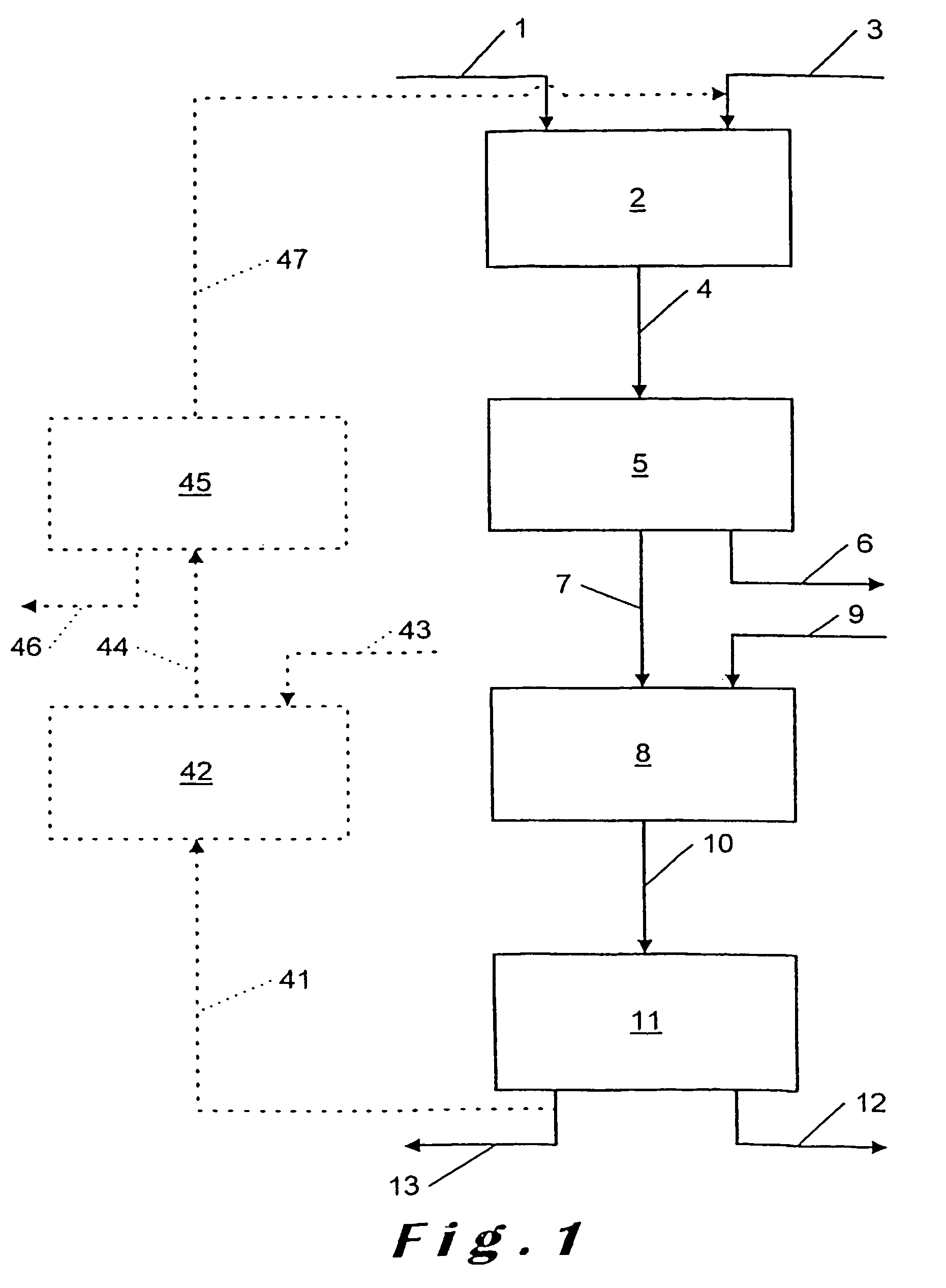Method of producing phosphoric acid salt
a technology of phosphoric acid and salt, which is applied in the field of producing phosphoric acid, can solve the problems of increased cost, significant corrosion problems, and difficult separation, and achieve the effects of reducing the recycling of hcl and corrosion problems, excellent yield and greater purity
- Summary
- Abstract
- Description
- Claims
- Application Information
AI Technical Summary
Benefits of technology
Problems solved by technology
Method used
Image
Examples
example 1
[0077]Phosphate ore of Moroccan origin which has a P2O5 content of 33% and a total CaO content of 50% (CaO representing all the Ca available in the ore as Ca3(PO4)2, CaCO3, CaO and other Ca compounds) is fed at a rate of 15 kg / h into a stirred reactor in order to be attacked there by a 5% by weight solution of hydrochloric acid. The feed rate of the HCl solution is 141 liters / h, which gives an HCl / Ca normalized ratio of 0.7, i.e., 1.4 mol HCl per mol Ca.
CaO present in the ore is: 50%×15 kg=7.5 kg CaO=0.1339 kmole Ca
P2O5 present in the ore is: 33%×15 kg=4.95 kg P2O5.
[0078]As the density of the HCl solution is approximately 1.15, the mass of added HCl is 141×1.15=163 kg.
[0079]The non-viscous attack liquor is then transferred into a filter press after intermediate passage through a buffer tank (residence time in the latter approximately 1 hour). The temperature remains ambient. The insoluble matter is separated in the filter press.
[0080]The solution emerging from the filter press is ro...
example 2
[0086]The conditions of Example 1 are repeated but in the neutralization reactors only calcium carbonate is added at a rate of 7.1 kg / hour, which gives a Ca / P molar ratio of 1.2.
[0087]The following table illustrates the composition of the various products obtained during a process as applied in Example 1.
[0088]
TABLEMoistureP2O5CaClNaKMgFSO4SiFe(%)(% m / m)(mg / kg)(mg / kg)(mg / kg)(mg / kg)(mg / kg)(mg / kg)(mg / kg)(mg / kg)(mg / kg)As (mg / kg)MCP filtrate 2.76 2836547735 124—505050—22.00.68Insolublescake33.92total13.52325430168352896585545207384122369200370012soluble 3.31 3632737516DCP cakeDry36.27289008 803623.55842.01MoistureAlCdCuPbZnNiCr(%)(mg / kg)(mg / kg)(mg / kg)(mg / kg)(mg / kg)(mg / kg)(mg / kg)Ti (mg / kg)V (mg / kg)U (mg / kg)MCP filtrate 41.8 0.420.319.53.96.233.03.1DCP cakeDry1390.651.3 3.7 363.5737.656
example 3a
[0089]In a stirred 2 liter reactor a solution of CaCl2 containing 50% CaCl2, as obtained as filtered mother liquors at the end of Example 1, is mixed continuously at a rate of 4 kg / hour with 96% concentrated sulphuric acid. The feed rate of the sulphuric acid is 0.54 kg / hour.
[0090]The residence time in the reactor is 30 minutes.
[0091]The pulp formed after the appearance of the gypsum crystals is then transferred into a Buchner filter. The temperature of the reaction is 40° C. The solution emerges from the filter at a rate of 3.36 kg / hour and contains mainly hydrochloric acid (10% HCl). It is recycled at the ore attack reactor for a new cycle. The gypsum cake (rate 1.18 kg / hour at 30% moisture) is washed and then discharged. The washing water is recycled with the filtrate. The cake obtained is mainly calcium sulphate dihydrate.
[0092]The addition of sulphuric acid is calculated so as to obtain in the pulp a Ca / H2SO4 molar ratio of 1.
[0093]Analysis of the hydrochloric acid solution rec...
PUM
| Property | Measurement | Unit |
|---|---|---|
| molar ratio | aaaaa | aaaaa |
| molar ratio | aaaaa | aaaaa |
| grain size | aaaaa | aaaaa |
Abstract
Description
Claims
Application Information
 Login to View More
Login to View More - R&D
- Intellectual Property
- Life Sciences
- Materials
- Tech Scout
- Unparalleled Data Quality
- Higher Quality Content
- 60% Fewer Hallucinations
Browse by: Latest US Patents, China's latest patents, Technical Efficacy Thesaurus, Application Domain, Technology Topic, Popular Technical Reports.
© 2025 PatSnap. All rights reserved.Legal|Privacy policy|Modern Slavery Act Transparency Statement|Sitemap|About US| Contact US: help@patsnap.com



